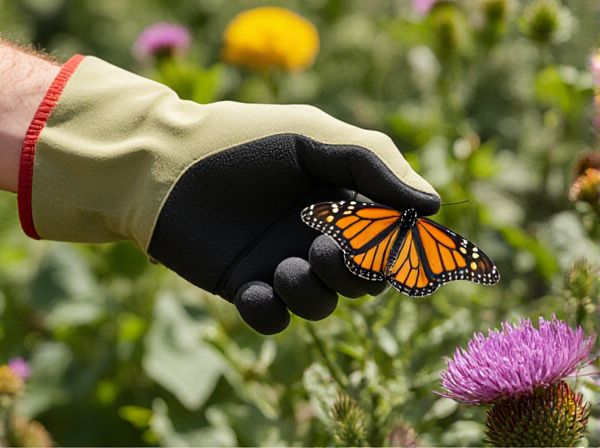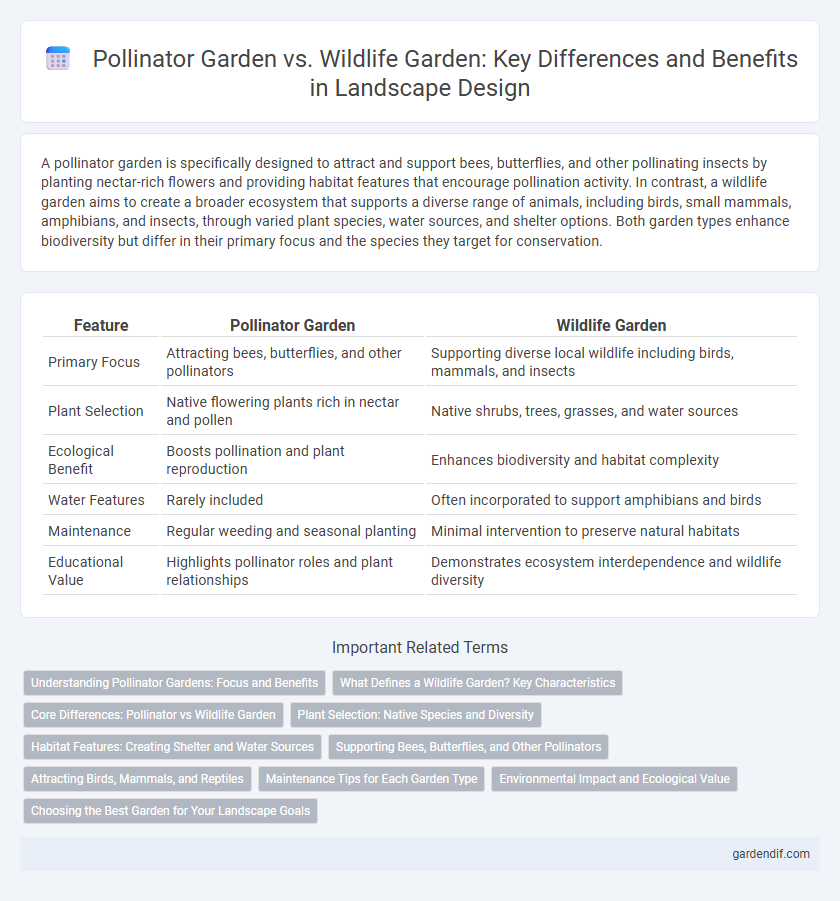
Pollinator Garden vs Wildlife Garden Illustration
A pollinator garden is specifically designed to attract and support bees, butterflies, and other pollinating insects by planting nectar-rich flowers and providing habitat features that encourage pollination activity. In contrast, a wildlife garden aims to create a broader ecosystem that supports a diverse range of animals, including birds, small mammals, amphibians, and insects, through varied plant species, water sources, and shelter options. Both garden types enhance biodiversity but differ in their primary focus and the species they target for conservation.
Table of Comparison
| Feature | Pollinator Garden | Wildlife Garden |
|---|---|---|
| Primary Focus | Attracting bees, butterflies, and other pollinators | Supporting diverse local wildlife including birds, mammals, and insects |
| Plant Selection | Native flowering plants rich in nectar and pollen | Native shrubs, trees, grasses, and water sources |
| Ecological Benefit | Boosts pollination and plant reproduction | Enhances biodiversity and habitat complexity |
| Water Features | Rarely included | Often incorporated to support amphibians and birds |
| Maintenance | Regular weeding and seasonal planting | Minimal intervention to preserve natural habitats |
| Educational Value | Highlights pollinator roles and plant relationships | Demonstrates ecosystem interdependence and wildlife diversity |
Understanding Pollinator Gardens: Focus and Benefits
Pollinator gardens are specifically designed to attract and support pollinating insects such as bees, butterflies, and hummingbirds by planting native flowering species that provide nectar and pollen throughout the growing season. These gardens play a crucial role in enhancing biodiversity, improving pollination for nearby crops, and sustaining declining pollinator populations essential for ecosystem health. Unlike general wildlife gardens, pollinator gardens prioritize floral resources and habitat features that directly benefit pollinator species, making them vital for environmental conservation and agricultural productivity.
What Defines a Wildlife Garden? Key Characteristics
A wildlife garden prioritizes creating a habitat that supports a diverse range of native species, including birds, insects, mammals, and amphibians, by incorporating natural elements like dense shrubs, deadwood, and water sources. It often features native plants that provide shelter, food, and breeding grounds, promoting biodiversity and ecological balance throughout all seasons. Unlike pollinator gardens focused mainly on nectar-producing flowers for pollinating insects, wildlife gardens aim to sustain a broader ecosystem for wildlife survival and ecological interactions.
Core Differences: Pollinator vs Wildlife Garden
A Pollinator Garden is specifically designed to attract and support pollinating insects such as bees, butterflies, and hummingbirds, emphasizing flowering plants rich in nectar and pollen. In contrast, a Wildlife Garden provides a broader habitat aiming to support diverse fauna including birds, small mammals, and amphibians, integrating features like water sources, shelter, and varied plant structures. The core difference lies in the targeted species and ecological functions, with pollinator gardens focusing on pollination services while wildlife gardens promote overall biodiversity and ecosystem balance.
Plant Selection: Native Species and Diversity
Pollinator gardens prioritize native flowering plants that provide nectar and pollen essential for bees, butterflies, and other pollinators, enhancing local ecosystem health. Wildlife gardens incorporate a broader range of native species, including shrubs, grasses, and trees, to support diverse fauna beyond pollinators, such as birds and small mammals. Selecting a variety of native plants with staggered blooming periods increases biodiversity and sustains wildlife throughout the seasons.
Habitat Features: Creating Shelter and Water Sources
Pollinator gardens emphasize planting native flowering species that provide nectar and pollen, alongside shallow water sources like birdbaths to support bees, butterflies, and hummingbirds. Wildlife gardens incorporate dense shrubs, logs, and brush piles to offer shelter for small mammals, birds, and amphibians, combined with more extensive water features such as ponds or wetlands. Both garden types enhance biodiversity by creating essential habitats, but pollinator gardens focus on supporting pollinators with flowering plants and accessible water, while wildlife gardens prioritize diverse shelter options and varied aquatic environments.
Supporting Bees, Butterflies, and Other Pollinators
Pollinator gardens prioritize planting nectar-rich flowers and host plants that attract and sustain bees, butterflies, and other pollinators, enhancing biodiversity and crop pollination. Wildlife gardens offer a broader habitat by integrating native shrubs, trees, and water sources, supporting not only pollinators but also birds, amphibians, and small mammals. Both garden types contribute to ecological balance, but pollinator gardens specifically target the foraging needs of vital pollinating insects.
Attracting Birds, Mammals, and Reptiles
Pollinator gardens primarily attract bees, butterflies, and hummingbirds by planting nectar-rich flowers and native plants, which support pollination and biodiversity. Wildlife gardens offer a broader habitat by incorporating features like dense shrubs, water sources, and diverse plant layers, effectively attracting a variety of birds, mammals, and reptiles. Strategic design with native vegetation in wildlife gardens enhances shelter, food supply, and breeding grounds, promoting a balanced ecosystem.
Maintenance Tips for Each Garden Type
Pollinator gardens require regular deadheading, watering during dry spells, and minimal pesticide use to support bees, butterflies, and hummingbirds. Wildlife gardens benefit from maintaining native shrubs, providing water sources, and leaving leaf litter or brush piles to create habitat diversity. Both garden types thrive with seasonal pruning and soil enrichment to promote healthy plant growth and ecological balance.
Environmental Impact and Ecological Value
Pollinator gardens primarily support bees, butterflies, and other pollinating insects, enhancing plant reproduction and biodiversity while contributing to food security. Wildlife gardens offer broader ecological benefits by providing habitat and food sources for a wide range of species, including birds, small mammals, amphibians, and insects, promoting ecosystem resilience. Both garden types improve soil health, reduce chemical use, and increase native plant populations, but wildlife gardens create more complex food webs and greater overall biodiversity.
Choosing the Best Garden for Your Landscape Goals
Pollinator gardens are designed to attract bees, butterflies, and other pollinators by featuring nectar-rich flowering plants like milkweed and coneflowers, supporting ecosystem health and enhancing crop pollination. Wildlife gardens prioritize diverse habitats, incorporating native shrubs, trees, and water sources to support a broader range of species including birds, amphibians, and small mammals. Selecting between pollinator and wildlife gardens depends on your landscape goals--choose pollinator gardens for focused pollinator support and increased plant reproduction, or wildlife gardens for fostering biodiversity and creating balanced ecosystems.
Pollinator Garden vs Wildlife Garden Infographic

 gardendif.com
gardendif.com